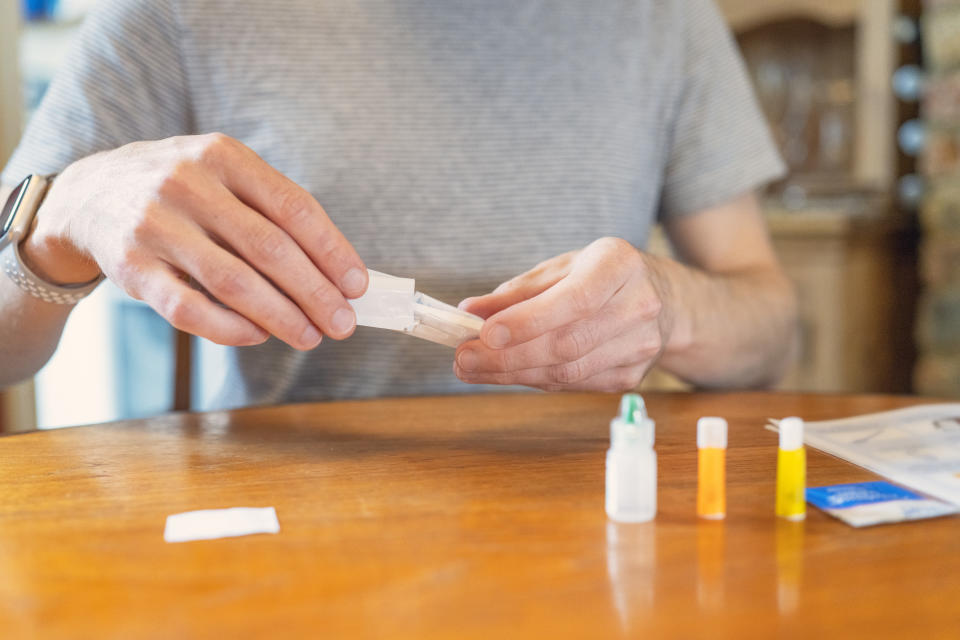Are at-home COVID-19 tests effective? New study shows they may be beneficial
Experts have been long been pushing for better, faster COVID-19 testing — driven not only by the more than 4 million confirmed cases in the United States but by multiple studies showing that even those without symptoms can be spreading the virus. This week new research suggests that at-home tests may provide some benefit, but in the midst of a pandemic that’s surging in more than half of America, will it be enough?
The standard COVID-19 test, a four-inch nasal swab collected by a clinician, has been plagued by supply-and-demand issues and overburdened labs, leading to hours-long lines outside clinics and seven-to-10-day delays in getting results. In early May, the Food and Drug Administration approved the first alternative option — an at-home saliva test for COVID-19. Since then the FDA has approved several other versions, many of which rely on a self-collected nasal swab.
But while the tests have been growing in popularity, questions about whether they’re effective or beneficial remain. In a new study released this week, researchers at the University of Washington School of Medicine suggest that they are both. Published in JAMA, the study involved 185 individuals — 158 of whom were health care workers — who all received COVID-19 tests.

Overall, 41 of the individuals (22 percent) tested positive for COVID-19 through either in-clinic swabs, self-collected swabs or both. The self-collected swabs, the authors write, correctly found 80 percent of the positive cases overall. The authors clearly outline the benefits of the at-home test, writing that it not only allows patients to “avoid going out when they don’t feel well,” thus reducing potential transmission, but also “gives public health officials a means to track the pandemic in communities among people who don’t seek care at hospitals, clinics and test sites.”
Dr. Janet Englund, a specialist in pediatric infectious diseases at Seattle Children’s Hospital, a professor of pediatrics at the University of Washington School of Medicine and one of the study’s co-authors explains that while the clinician-collected swab was more accurate, the self-collected swabs’ accuracy increased in individuals with higher viral loads (or more virus) — suggesting it may be a good option for those are extremely ill.
“In our paper we show that when there’s more virus present, which is typically what's happening around the first 10 to 12 days of the disease, the test actually performed very similar to the nasal [clinician-collected] swab,” says Englund. “So our recommendation is early on in disease, this test approach really seems quite reasonable. ... Two weeks or more after the onset of symptoms, this particular approach may not be the optimal way to diagnose.”
Yahoo Life Medical Contributor Dr. Dara Kass agrees that the test could prove beneficial. “It does decrease the first barrier to testing, which is making appointments, because patients can swab themselves at home,” says Kass. “If people were empowered to have swabs at home for when they felt sick, it would cut out that timeline of getting to a physician.” Kass says that an ideal scenario would be sending “every home in America three swabs” to have on hand if someone got sick.
But even if that were possible, she says the issues that have been occurring with the standard COVID-19 test may still apply, in particular delays in processing the results at a lab.
“If the lab only has supplies to do a certain number of tests per day, and they get twice as many as those tests that day, then half the batch gets processed the next day,” says Kass. “The higher the demand the longer the timeline ... so this will make testing accessible but it won’t solve processing issues. So it’s good news — it’s just not the answer.”
For the latest coronavirus news and updates, follow along at https://news.yahoo.com/coronavirus. According to experts, people over 60 and those who are immunocompromised continue to be the most at risk. If you have questions, please reference the CDC’s and WHO’s resource guides.
How to maintain your physical and mental health during the pandemic
Taking care of a loved one with COVID-19? Here’s how to stay healthy
Q&A with Dr. Kavita Patel: How to keep your family safe and maintain your mental health
Read more from Yahoo Life
Why didn’t summer kill the coronavirus? Experts explain what White House officials were missing
‘I’m proud of my disability’: How a wheelchair ramp and the ADA changed my life
Want daily lifestyle and wellness news delivered to your inbox? Sign up here for Yahoo Life’s newsletter.

 Yahoo Sports
Yahoo Sports 